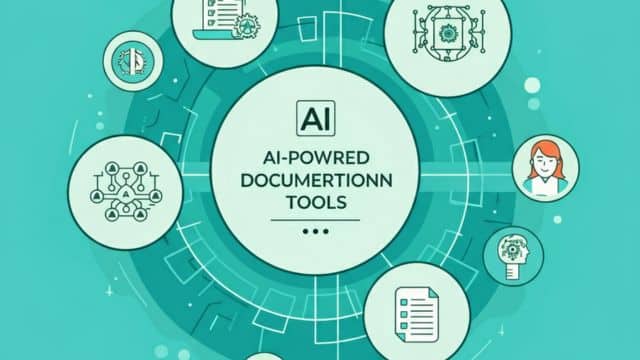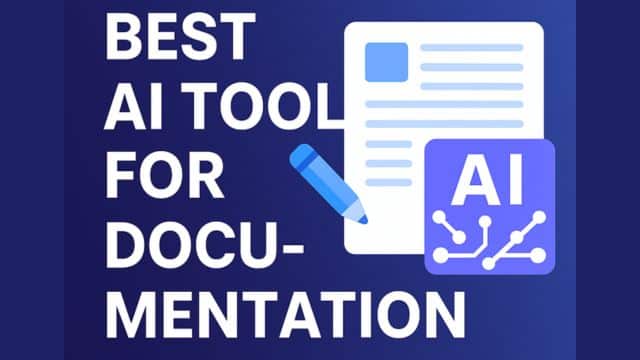Every organization facilitates documentation because it gives smooth arrangement of work, sharing of knowledge and interaction. Standard documentation methods take a lot of time and effort. But the game changer nowadays, AI powered documentation shifts all of that hard work into automation with great precision.
AI transforms every aspect of creating, managing, and maintaining documentation. AI tools are beneficial with accuracy in saving time and reducing resource costs with its features like technical manuals, process guides and internal wikis. Reviewed in this article are the 9 best AI tools for documentation tools I wills stan in 2025 to guide you in finding your ideal tool.

So, What Exactly Is AI-Powered Documentation?
With AI documents, everything is automated which means there is no any organization that will not like this service. AI powered tools make documents creation more effortless while organization and updating them becomes more easier too. Powerful algorithms of machine learning, natural language processing (NLP) and other features of automation help in accomplishing time wasting chores in a simple manner.
Read Also : Boost Your Work Efficiency with These AI Productivity Tools in 2025
Advantages Placed By AI Documentation Tools:
- Speed As Well As Efficiency: In drafting content or editing it for the very first time, AI decreases the time that would have been spent. This endorses smoother workflows.
- Accuracy: With the usage of NLP, these documents are bound to have errors free grammar, structure and contextual documentation.
- Reduced Manual Undertaking: Anti repetitive procedures like automation of formatting, document control and version control boosts manual undertaking.
- Enhanced Collaboration: Numerous tools permit real-time interaction for empowered cross functional collaboration.
- Scalability: The AI tools are suitable for growing organizational needs and changing requirements of the content.
With these advantages, it is easy to see why documentation powered by AI is becoming indispensable for businesses that wish to increase output while ensuring uniformity.
Your Guides for Selecting AI Documentation Tools
While choosing the right tool may seem challenging at first, concentrating on several important criteria can be very helpful.
Accuracy
This refers to the AI’s ability to generate high quality content without the presence of mistakes.
Ease of Integration
The tool should work effortlessly with already existing systems (including CRM and project management software).
User Friendliness
No extensive training sessions should be required for staff to work with AI, so award winning interfaces should be prioritized.
Flexibility, Customization, and Scalability
The tool must be able to serve the distinct needs of a business and also expand in accordance with the growth of the organization.
Cost and Support
A balance should be struck between having prompt support for troubleshooting when needed, and staying within budget constraints.
These tips harness the identified features making the price advantageous for the potential buyer.
List of Best AI Tools for Documentation

For now, this is that list of tools dedicated to AI documentation in 2025. These three are first on my list.
1. Document360
Overview
Document360 is one platform for creating a thorough internal knowledge base whereby all employees can access the company’s files while actively collaborating with one another.
Key Features
- AI-recommended content
- Enhanced real-time document editing features
- Real-time collaboration with colleagues
- Discover behavioral data analytics
Pros
- User-friendly interface
- Comprehensive analytics available for effective optimization
Cons
- May be too expensive for smaller companies
2. GitBook
Overview
GitBook is ideal for developers and engineering-centric teams, as it streamlines documentation for software projects.
Key Features
- AI-assisted formatting
- Supported markdown
- Well structured hierarchy with ranked levels of texts
Pros
- Sleek, uncluttered interface
- Well suited for technical documentation
Cons
- Little to no customization options
3. Archbee
Overview
Archbee offers collaborative and fast-paced internal documentation or public knowledge portal building tools, perfect for product teams.
Key Features
- AI-based editing tools
- Document archives
- Content modules
Pros
- Tailored for product-based teams
- Robust search functions
Cons
- Few integrations
4. Tettra
Overview
Tettra excels in team-based knowledge management by allowing users to create, manage, and retrieve documentation all in one platform.
Key Features
- AI prediction-supported answer suggestions
- Slack and MS Teams integration
- Access control
Pros
- Highly-referenced knowledge base from diverse team members
- Easy to use
Cons
- Premium plans required to unlock advanced features
5. Notion AI
Overview
Known for its versatility, Notion AI enhances the usability of Notion’s workspace with automated documentation capabilities.
Key Features
- AI writing assistance
- Multi-format support (text, kanban boards, etc.)
- Integration with external apps
Pros
- Highly customizable
- Offers a variety of document formats
Cons
- Can feel overwhelming for new users
6. Jasper AI
Overview
Offers procedure documents and blog documents as part of its content generation focus.
Key Features
- Provides AI document generation
- Supports tone adjustments
- Offers multilanguage support
Pros
- Supports numerous applications
Cons
- Does not provide adequate collaboration features
7. ClickHelp
Overview
ClickHelp services both users and technical writers with advanced documentation features which benefit all business sizes.
Key Features
- AI optimized search features
- Various import/export formats
- Reader feedback collection tools
Pros
- Sophisticated feedback system
- Comprehensive user documentation
Cons
- Documents may be easier to write than to learn to use
8. Scribe AI
Overview
Scribe AI streamlines procedural documentation automation where users can capture and curate guides step by step.
Key Features
- Auto-generated Visual Scribes
- Easy Download and Sharing
- Browser Extensions
Pros
- Excellent for Process Documentation
Cons
- Outside the Workflows, There Are Limited Use Cases
9. Grammarly
Overview
Editing For Grammarly Involves Writing And Content Structures Error-Free Checks.
Key Features
- Grammatically And Stylistically Uses A Checker
- Plagiarism Detector
- Integration On Numerous Platforms
Pros
- Tap Writing Accuracy
Cons
- Poor Customizability Focused On Technical Documents

How To Integrate AI Tools Into Your Documentation Workflow
- Identify The Pain Points Of Your Team
- Train Sessions Devoted To The Use Of These Tools Foster Confidence And Reduces Errors
- Workflow Definition Avoids Mistakes
- Performance Monitoring: Tracking Using The Tool’s Strategic Performance Analytics Features
Frequent Asked Questions
1.What Benefits Are There For AI Documentation Tools?
Scribe AI and Grammarly combined are revolutionary tools for documentation, with one enabling users to rapidly automate their documentation processes and boost their productivity, while the other enables document prep, structure and checks ensuring terms of errors – providing a professionally polished content.
2. Are these tools good for small businesses?
Definitely! Tools like Scribe AI and Notion AI even have special budget-friendly pricing for small teams.
3. How secure are AI documentation tools?
Most tools have sophisticated encryption methods and secure data handling that meets industry standards.
4. Do AI tools replace people’s work entirely?
No, humans need to provide context and make important decisions so, while AI increases productivity, human judgment is necessary.
Conclusion
AI documentation tools are transforming content management within organizations. In addition to automation, which reduces the burden of repetitive tasks, these tools leverage collaboration, thereby providing comprehensive value. While Document360 and Notion AI are great multi-purpose options, Scribe AI shines as a specialized documentation tool.
Read Also : Top AI Companies in Austin in 2025: Why This City Is the New AI Hub


